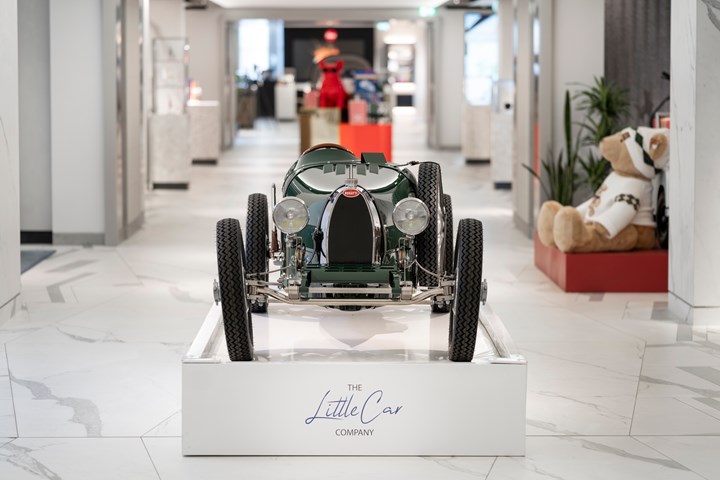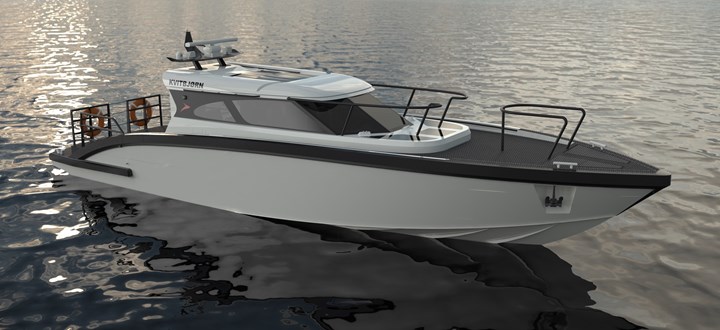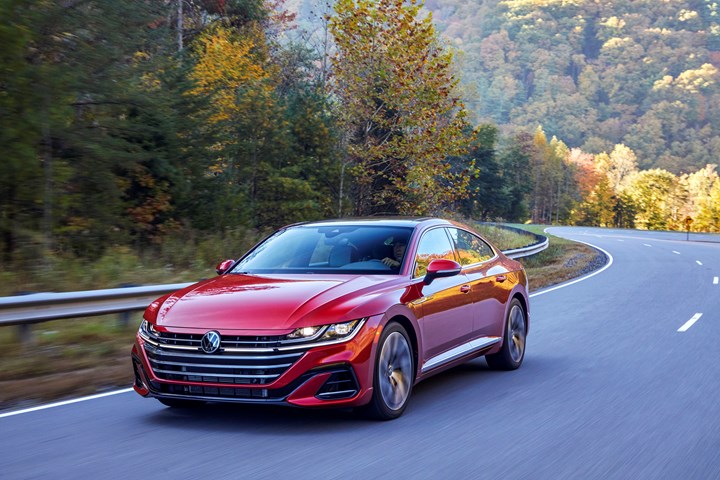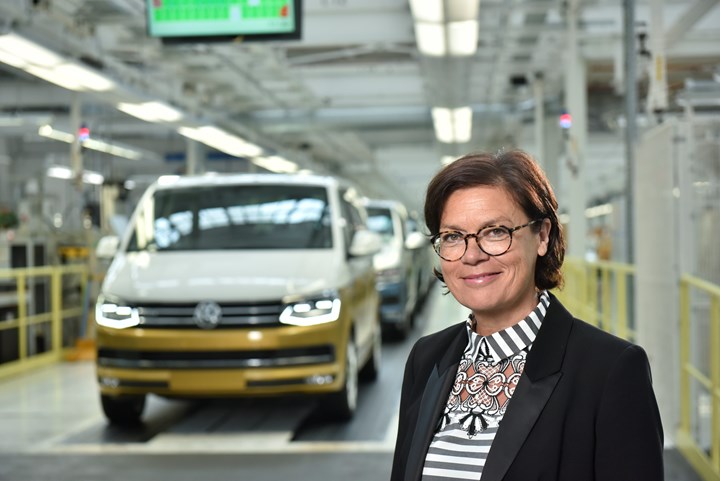On a Baby Bugatti EV, a Hybrid Boat and the Future of Works
On the diminutive electric Bugatti you didn’t know you wanted; interesting predictions about apps, electrification and data; a Scandinavian hybrid tourist boat development; the VW Arteon sedan; and employment considerations in car plants as a result of electrification
#workforcedevelopment
This week On Automotive
- An EV for Christmas?
- Prescient Predictions?
- Hybrids and e-Mobility-as-a-Service
- Volkswagen Arteon 2.0T SEL R-Line
- Jobs & the EV Future
///
An EV for Christmas?

The Baby Bugatti II at Harrods. An electric car with a composite body. Just, well, small. (Image: The Little Car Company)
As Christmas is around the proverbial corner, here’s something you might want to know about: the Bugatti Baby.
Back in 1926 Ettore Bugatti gave one of his sons a half-scale Type 35 for the lad’s fourth birthday. Others became aware of the vehicle and from 1927 to 1936 the Bugatti Baby was sold by the brand.
The car is back in a up-to-date configuration.
The Bugatti Baby II is being hand-built in the U.K. under license by The Little Car Company.
This particular little car is a 75% scale version of the Type 35.
There are three versions, all with rear drive and electric powertrains:
- Base. It operates in two modes: Novice, limited to 12 mph and 1 kW of power; Expert, 30 mph and 4 kW. It has a 1.4-kWh battery pack. The body is fabricated with composites. The starting price is €30,000.
- Vitesse. In addition to the Novice and Expert modes of the Base, it also offers a third mode unlocked by the “Bugatti Speed Key.” This allows 10 kW of power and a top speed of 42 mph. It has a 2.8 kWh battery pack. The body is a higher-grade composite using carbon fiber twill. The starting price is €44,300.
- Pur Sang. Same performance specs as the Vitesse but this version has hand-made aluminum body work (just like the original Baby and the full-size Type 35).
In case you happen to be in London, there is a Bugatti Baby II on display on the fifth floor of Harrods.
Incidentally: the production is limited to 500 vehicles.
///
Prescient Predictions?
BlackBerry (yes, the company that once had the lead in mobile phones until that iPhone got in the way of those clever devices with tiny keyboards) has undergone notable transformation and is now, among other things, doing significant development work in vehicular software development.
For example, it is working with AWS on a scalable, cloud-connected software platform, BlackBerry IVY, that collects sensor data, normalizes it, and then provides actionable insights from that data. While it is connected to the cloud (which explains, in part, AWS), it operates on the “edge,” or within a vehicle’s embedded systems, with management and configuration coming from the cloud.
Sarah Tatsis, is senior vice president, BlackBerry IVY Platform Development. And as this time of year is when people come out with some predictions, here are some of her informed observations on what may occur:
- Apps Matter
I fully expect to see a series of applications that support and complement each other emerge over the next couple of years that will drive a big change in vehicle purchase decisions for both consumers and commercial fleets alike. There’s a good chance that we’ll see several versions of level 2, 3, and 4 automations, along with several mapping, battery management, and experience applications to support them. Differing laws, automotive offerings, and personal preference will drive much of this and ultimately which applications achieve critical mass.
- Electric Happens
As governments around the world have stuck by their mandates from the Paris Agreement, automakers are trying to get ahead of the regulations. We will see all electric vehicles become more accessible, affordable, and prevalent, and as gas prices rise, we will see consumer and fleet demand for electric vehicles increase.
- Data Costs
There will continue to be no shortage of data that can be pulled off the vehicle. However, the ever-present challenge that often gets overlooked is the considerable connectivity and storage costs, particularly if you don’t have a purpose for the data. Having the ability to run machine learning models and process data on the edge (inside the vehicle) is going to become increasingly important so that OEMs don’t have to send all that data up to the cloud and incur additional fees. Dynamically pulling data at key moments in time is the way the industry is headed. For instance, say a fleet of vehicles is stuck in traffic and each one of them is continually sending info up to the cloud. Ultimately, OEMs want to be able to send a message down to all of vehicles that says, “Only send me a message once the situation has changed” so that they don’t incur the additional fees that accompany the constant pinging of the same update. Think of it as the evolution of the “Are we there yet? Are we there yet? Are we there yet?” refrain that all most parents are familiar with.
- Downloads as “Options”
From an automotive software standpoint, personalization is the future. The move to EVs, the consolidation of ECUs, and the increase of connectivity and compute power open a world of opportunities players across the transportation spectrum. I see a world where we can add, customize, and optimize the functions of the car, as needed, a trend which is a huge boon for smaller application players looking to tap this vast and growing market. We’ll see autonomous driving, safety components and other features as a choice for a downloadable app rather than a dealer option. We’ll see app after app pop up from OEMs, technology companies, telcos and smaller players all looking to serve consumer demand for automated driving, connectivity, convenience and shared mobility.
Odds are, Tatsis will be right about plenty of this.
///
Hybrids and e-Mobility-as-a-Service

Kvitbjørn (“Polar Bear”), which is powered by a Volvo Penta hybrid system. Yes, even boats are going hybrid. (Image: Volvo Penta)
Quick: Think of a hybrid vehicle. What comes to mind?
Probably a Prius, even though there are certainly an array of hybrid-powered vehicles available now, everything from compacts to utes to luxury vehicles to Norwegian sight-seeing boats.
Huh?
Well, a tourist operator that takes tourist to Svalbard, an archipelago located between mainland Norway and the North Pole, Hurtigruten Svalbard, is testing a state-of-the-art Marell M15 vessel, the Kvitbjørn (“Polar Bear”), that is powered by a a Volvo Penta twin D4-320 DPI Aquamatic, a hybrid.
The tests are being conducted at the Volvo Penta marine test facility in Krossholmen, Gothenburg, Sweden. Then it will go to Marell Boats in Östhammar. It is planned to arrive in Svalbard in May 2022 to be put in service, running tourist day trips.
It has a top speed of 32 knots and a cruising speed of 25 knots. It has a range of 500 nautical miles.
- This drivetrain combines a diesel engine and an electric motor.
Peter Granqvist, from Volvo Penta. “We designed the complete system to work seamlessly as a single package. We favor this approach and it’s been a differentiator for us for some time. Through it we can deliver better driveline performance, maneuverability and acceleration compared to traditional installations. The parallel hybrid system is very responsive and provides seamless power transition between the electric and diesel propulsion.”
The boat can be propelled on electricity alone, but at this point Volvo Penta does not want to divulge the details.
And not only is this about hybridization, but there is another aspect to what Volvo Penta and Hurtigruten Svalbard are doing:
e-mobility-as-a-service
Hurtigruten Svalbard will trial paying by the kilowatt-hour for the motor’s operation. The boat is boat set to run for more than 1,000 hours during the tourist season (May 1st – October 31st).
It is anticipated that if this payment method works, the companies think it could change how customers acquire marine e-mobility. One factor is that the upfront costs are often a barrier, and this could mitigate that.
///
Volkswagen Arteon 2.0T SEL R-Line

The VW Arteon. Yes, a sedan. Yes, a flagship for the brand. Yes, stylish and substantive. (Image: VW)
The thing about the Volkswagen Arteon is that it is VW’s “flagship sedan.” And the problem is that (1) people probably don’t think about Volkswagen having a “flagship sedan” (possibly a flagship crossover, but the MSRP for the top-of-the-line Atlas SEL Premium R-Line AWD is just $50,645 and for some “flagship” models from other OEMs that’s just scratching the surface) and (2) there don’t seem to be many people who even consider this car because during the first three quarters of 2021 VW delivered merely 4,865 of them.
Which is something of a shame for those people who really are interested in buying a nice car because, well, it is a nice car that can seat five and the number of vehicles like that is simply becoming more difficult to find unless you go to another German brand (e.g., VW sibling Audi) or to an Asian brand (e.g., a Toyota Avalon or a Kia Stinger).
Arguably the Arteon is in the space that once included offerings from Buick (and I can hear the howls in Wolfsburg with that) but it has gone entirely to crossovers. If we go to Lincoln, again, it is phasing out its remaining MKZs and Continentals for a slate of SUVs.
Volkswagen still offers cars. And with the Arteon, a very nice car. For those who are looking for an exhilarating driving experience there are the GTI and Golf R. For those who are looking for something more modest, the Jetta. And something in between the Passat which, is going away.
The car
The Arteon is a German car. The final assembly is performed at a VW plant in Emden, Germany.
It is powered by a turbocharged 2.0-liter four that produce 300 hp and 295 lb-ft of torque. To get those performance numbers, incidentally, premium is recommended. Not required. But recommended. Remember: this is a flagship.
The vehicle is available with all-wheel drive (the 4Motion system operates such that under ordinary conditions the front wheels are driven; should something change in traction demands, the rear wheels are powered, as well; what’s more there is a cross-differential lock fore and aft that operates like a limited-slip differential to help in actions like cornering).
Looks
The sheet metal is stylish, although not as striking as say the Acura TLX (a competitor). VW has developed a signature front-end look for its vehicles that includes a lightbar that stretches across the grille and surrounding the centered badge (“light is the new chrome” is the approach); the Arteon has it. What is probably more germane is that LED headlamps are standard, and for those who opt for higher trim levels there is adaptive front lighting that does things like move the direction of the headlamps when going into a turn.
An important element of the interior of the vehicle is that 12-way power, heated front seats are standard, with the entry trim having “leatherette” seating surfaces and the higher trims Nappa leather.
Tech
In terms of the increasingly important infotainment, there is VW’s MIB3 system. While the screen has capacitive touch capability (like your phone, which means a tap rather than a push), I find the interface (i.e., what’s shown on the screen) to be less engaging than those found on the systems of other OEMs. Of course, familiarity with the system over time would breed familiarity.
From the safety and assistance sphere, there’s the VW IQ.DRIVE, which includes front and rear radar, a front camera and ultrasonic sensors so that there is the capability to engage semi-autonomous hands-on driving, which essentially means that there is adaptive cruise that is blended with lane centering capability; hands must remain on the wheel, capacitive sensors assure that’s the case. And there are the other capabilities, like front collision warming, blind spot assist, lane assist, etc.
The aforementioned ultrasonic sensors are also used for park distance control, which helps alert the driver when making a parking maneuver that things are getting. . .close.
Thought
If you, like plenty of people, have spent your time of late behind the wheel of a CUV or a pickup truck, you really ought to take a quick spin in something like the Arteon: You will probably be surprised at how pleasurable and comfortable a car can be.
///
Jobs & the EV Future

Bertina Murkovic, chair of the Works Council at Volkswagen Commercial Vehicles: “Certainty during times of change is our message and demand.” (Image: VWCV)
While on the subject of Volkswagen. . .
One of the things that there seems to be more attention paid to in Germany than in the U.S. are the consequences of electrification on jobs.
The simple thing is this: Manufacturing EVs is less worker-intensive than ICE vehicles. And the German works councils are strong in protecting jobs.
A case in point of how this is playing out was announced last week regarding the Volkswagen Commercial Vehicles (VWCV) plant in Hannover.
Plan Goes Awry
Last summer a new assembly line was going into the plant, scheduled to go on-line in 2025. This was to be used to produce premium EVs for Audi and Porsche on a Porsche-developed platform. . .and then Porsche decided to change the platform.
So that was lost to the plant while the Audi would remain, with that vehicle being based on the Artemis Project platform. The plant will also be building the body of a forthcoming Bentley.
As Bertina Murkovic, chair of the Works Council at Volkswagen Commercial Vehicles, put it, ““After the disappointment of Porsche deciding against the Hannover site, we have now agreed the investment for a future of high utilization levels in Hannover and good strategic prospects for the VWCV brand.
“The fact that we are developing the ID. Buzz into the camper segment too is good news for Hannover! The other derivatives decisions for the new Multivan are also to be seen very positively. All in all, with the products now agreed we are at full capacity for this decade. Now we need to get our workforce ready for the changes. The emphasis over the next few years will be on the transformation of the personnel. It is precisely in relation to this that we have described the basic framework in our new agreement: job security is the foundation! Every man and woman will be appropriately deployed and trained.
“Despite all the change and the necessity for it – people will come along on the journey if they sense that their concerns and reservations are being taken seriously. Certainty during times of change is our message and demand.”
Know This
A couple things are notable in that:
- “Transformation of the personnel.” Changing what’s being built means that its not just the components need modification. The workers do, too.
- “Appropriately deployed and trained.” There is an acknowledgement that there is a responsibility for workforce training and that there are likely to be changes in what someone does in the plant.
Additional Emphasis
Dr Astrid Fontaine, member of the VWCV Brand Board of Management responsible for People and Transformation (and what a great title that is!), underscored that by saying:
“With this agreement we can continue to rule out any operational redundancies at the Hannover site through to the end of 2029 and guarantee more than 10,000 jobs. In order to successfully organize the fundamental transformation at VWCV, important changes are required over the coming years in terms of the workforce. Digitalization and electrification of our products will lead to jobs continuing to change fundamentally – some jobs will no longer be needed, new ones will be added. In order to train up our team for the new tasks and to get everyone fit for the future, we are investing from next year through to the end of the decade a further 21 million euros.”
Yes, they are committed to maintaining jobs and are investing in doing so.
Meanwhile, in Japan. . .
And consider this from Japan on the subject of transitioning the auto industry and jobs:
Akio Toyoda is not only CEO of Toyota Motor Corp., but chair of the Japan Automobiles Manufacturing Association (JAMA).
This past September Toyoda said at a JAMA meeting:
“If internal combustion engines are referred to as the ‘enemy’ in the battle of carbon neutrality, we wouldn’t be able to produce most of our vehicles. In our estimate, non-ICE vehicles [EVs and fuel cell vehicles] will not reach two million units even in 2030, so in that case, vehicle production of more than eight million units would be lost.”
The Japanese auto industry produces approximately 10 million vehicles per year, of which five million are exported.
Toyoda continued:
“If that happens, even in the automotive industry that increased 120 thousand jobs during the COVID-19 pandemic last year, we might lose the vast majority of our 5.5 million jobs.”
While there is a lot of emphasis made about batteries and vehicle range and the like, jobs need to be a huge consideration for OEMs.
Remember: one of the reasons Henry Ford established the $5 day was so his employees would be able to buy the vehicles they were helping produce.
If auto workers are displaced in considerable numbers as a result of a transition to EVs, who is going to buy those vehicles?
(Note: Earlier this week Akio Toyoda announced a new electrification initiative in which the company will, by 2030, have 30 BEVs across Toyota and Lexus, and sell, globally, 3.5 million of them annually.
The headlines proclaimed the $35-billion investment in electric vehicles. Then it was on to Toyoda backtracking on EVs.
What the headlines didn’t include is that the company is investing another $35 billion—in electrified vehicles, as in hybrids.
Clearly, he wants balance in production.)
RELATED CONTENT
-
Mustang Changes for 2018
On Tuesday Ford unveiled—using the social media channels of actor Dwayne Johnson (this has got to unnerve some of the auto buff book editors)—the 2018 Mustang, which has undergone some modifications: under the hood (the 3.7-liter V6 is giving way to a 2.3-liter EcoBoost four, and a 10-speed automatic is available), on the dash (a 12-inch, all-digital LCD screen is available for the dashboard), at the tires (12 wheel choices), on the chassis (MagneRide damper technology is being offered with the Mustang Performance Package), and on the exterior (three new paint colors). And while on the subject of the exterior, there are some notable changes—a lower, remodeled hood, repositioned hood vents, new upper and lower front grilles, LED front lights, revised LED taillamps, new rear bumper and fascia.
-
GM Is Down with Diesels
General Motors is one company that is clearly embracing the diesel engine.
-
on lots of electric trucks. . .Grand Highlander. . .atomically analyzing additive. . .geometric designs. . .Dodge Hornet. . .
EVs slowdown. . .Ram’s latest in electricity. . .the Grand Highlander is. . .additive at the atomic level. . .advanced—and retro—designs. . .the Dodge Hornet. . .Rimac in reverse. . .


.jpg;width=70;height=70;mode=crop)






